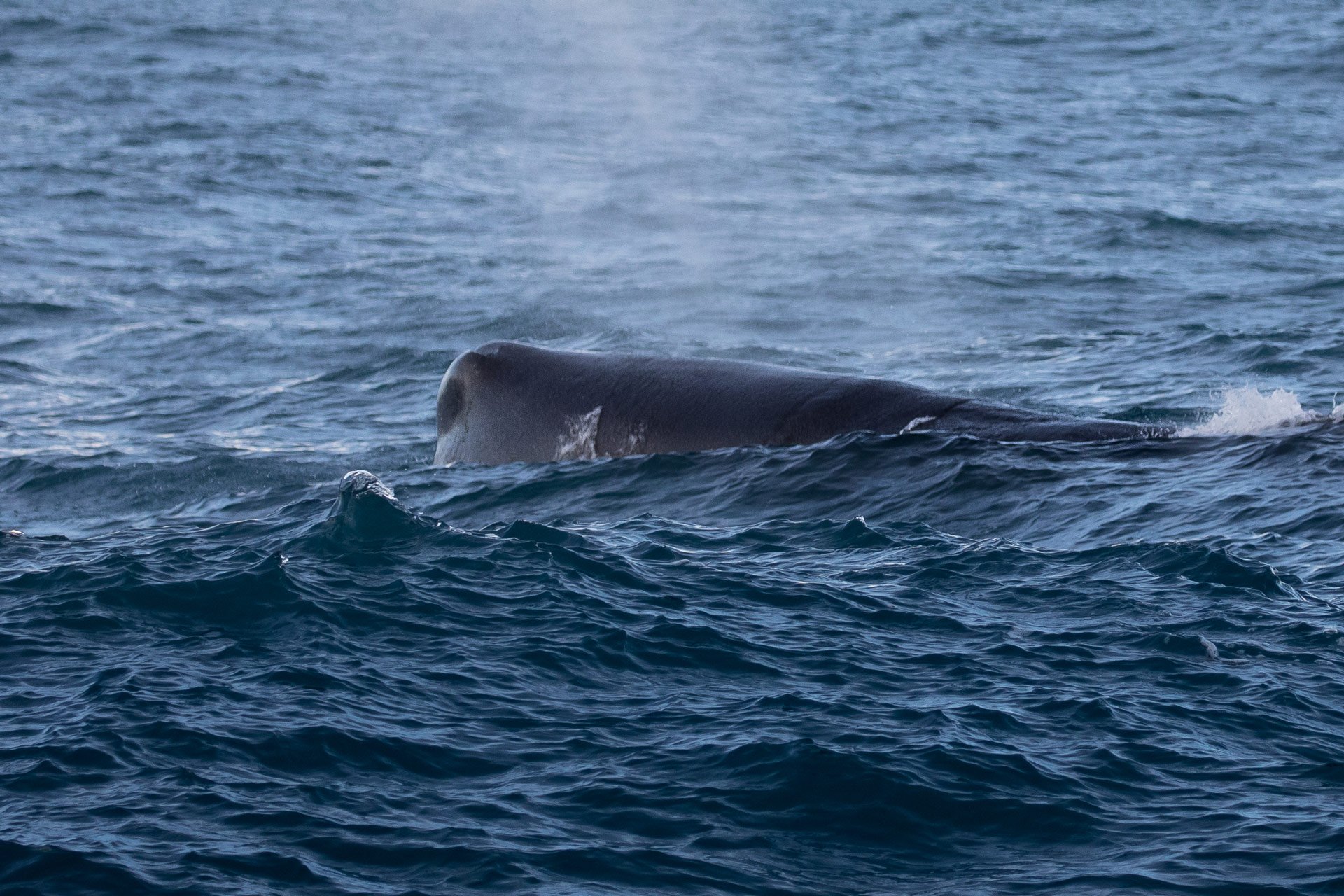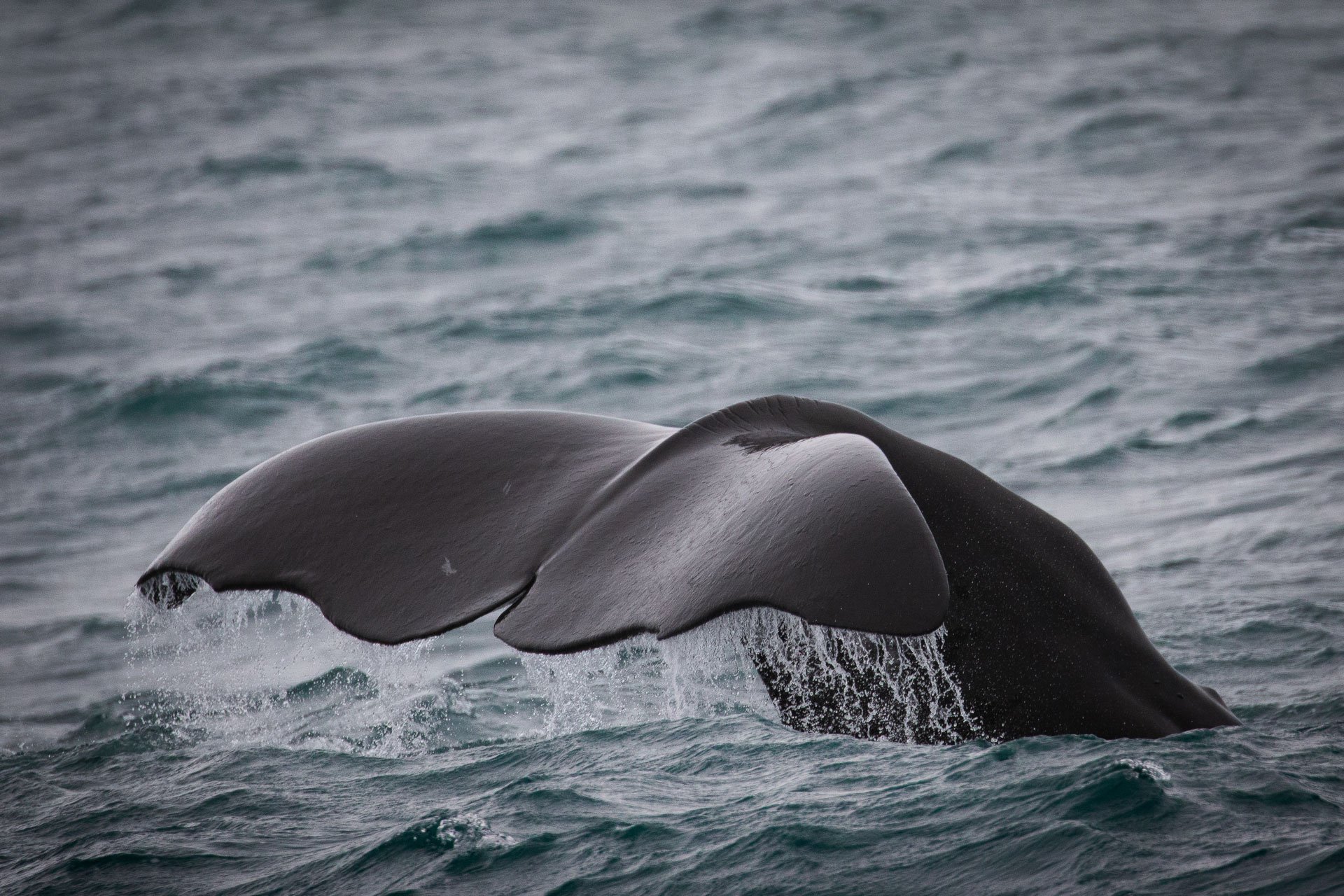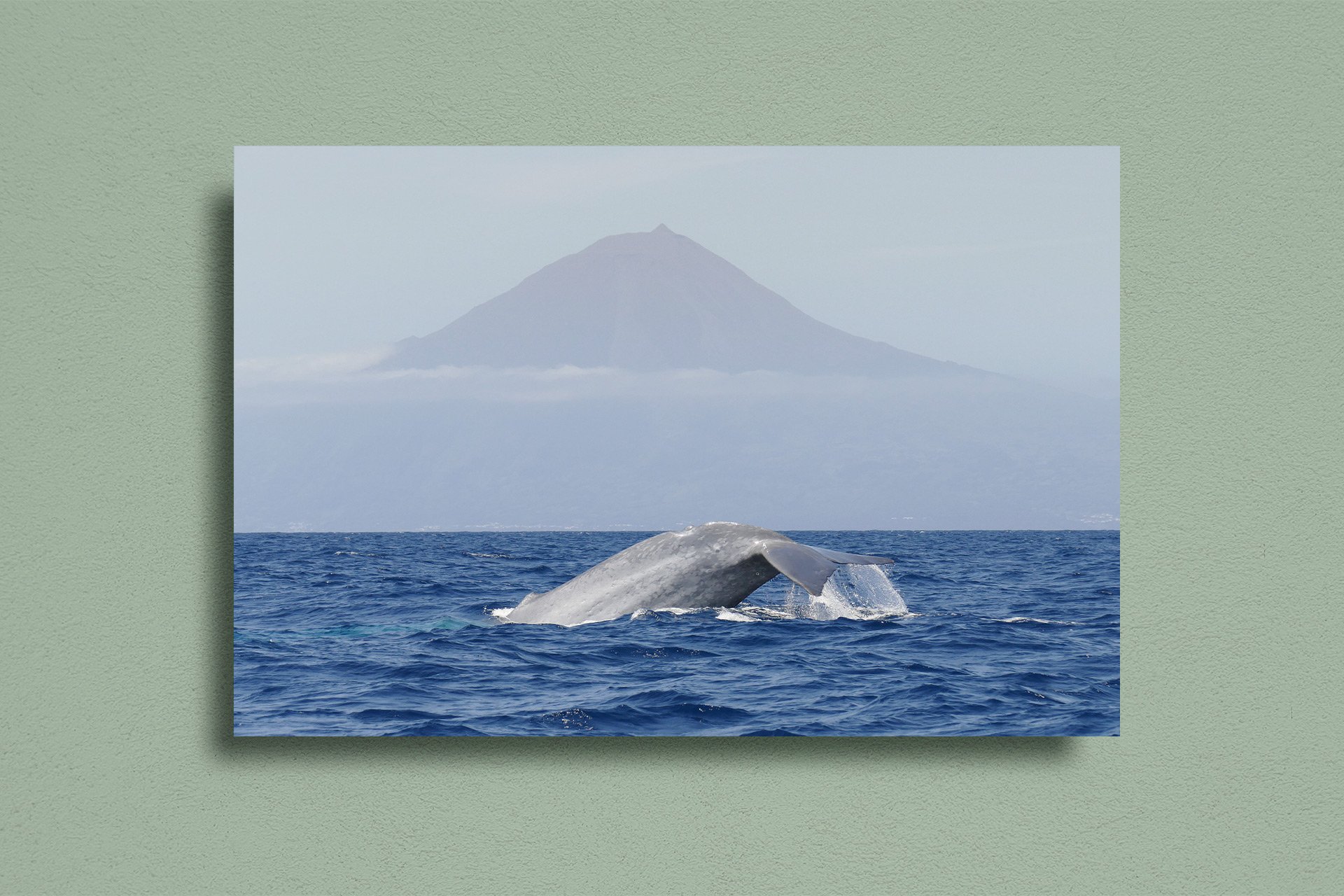POTTWALE
Die grössten Raubtiere des Planeten. In Norwegen, Neuseeland und vor den Azoren trifft man sie nah an der Küste.
Foto: Oliver Dirr / Whaletrips
REVIEW: Pottwale
Pottwale sind die größten Räuber der Welt und haben den größten Kopf im gesamten Tierreich. Sie können bis zu drei Kilometer tief tauchen und dabei fast alle Systeme auf Standby stellen.
Pottwale sind die mit Abstand besten Wale zum Einstieg in das Thema Whale Watching. Erstens sind Pottwale die bekanntesten und berühmtesten Wale (Moby Dick!). Zweitens kann man Pottwale zwar nur an sehr wenigen Orten auf der Welt touristisch begegnen – dort sind sie allerdings sehr zuverlässig anzutreffen. Drittens sind sie über Hydrofone leicht zu orten und über ihren schräg nach links gerichteten Blas und den massiven Schwanz noch leichter zu identifizieren. Und viertens liegen sie nach dem Auftauchen minutenlang regungslos an der Oberfläche herum und heben vor dem Abtauchen wirklich immer die Fluke, was die allerbesten Fotos ergibt. Pottwale sind also die perfekten Whale-Watching-Wale.
Einerseits.
Andererseits sind Pottwale von allen Großwalen aber auch die einzigen mit Zähnen und insgesamt die größten bezahnten Räuber der Welt. Ich gebe gern zu, dass mir schon ein wenig mulmig wurde, als ich in Andenes, Norwegen, vor dem lebensgroßen Modell eines 20-Meter-Pottwals stand und wusste, dass ich direkt im Anschluss in einem 5-Meter-Zodiac-Schlauchboot über einem Tiefsee-Canyon voller Pottwale herumfahren würde. Ein einzelner Pottwal-Zahn ist ca. faustgroß, zumindest wenn man eine große Faust hat – und von diesen faustgroßen Zähnen hat der Pottwal also über 40. Damit jagt er in Tiefen von bis zu 2.000 Metern nach Riesen-Kalmaren, die sich mitunter heftig zu Wehr setzen, wie die zahlreichen Narben an den riesigen Wal-Köpfen beweisen.
Tiefsee-Canyon, Riesen-Kalmare, Monster-Zähne. Und man selbst im Mini-Zodiac. Da macht man sich dann schon so seine Gedanken.
„Bei langen Tauchgängen können Pottwale ihren Herzschlag verlangsamen, gerade nicht benötigte Organe abschalten und bei Bedarf auch ihre Lungen kollabieren lassen.“
Gut zu wissen, dass Pottwale absolut friedlich und sozial sind, auch wenn das in »Moby Dick« etwas anders dargestellt wurde. Im Grunde sind Pottwale ein bisschen wie Kühe, nur viel schlauer und faszinierender. Pottwale haben zum Beispiel den größten Kopf im gesamten Tierreich, er kann bis zu 1/3 der Gesamtlänge ausmachen – ein Kopf so groß wie ein Pickup-Truck. Drin ist einerseits das größte Gehirn im gesamten Tierreich (bis zu acht Kilo), andererseits eine riesige Menge eines gelblichen, wachsartigen Öls (Walrat), wegen dem Pottwale jahrhundertelang bis kurz vor die Ausrottung gejagt wurden.
Dieses Öl dient vermutlich zur Steuerung des Auftriebs bei Tauchgängen. Es kann mit Hilfe des Meerwassers erhitzt oder gekühlt werden und damit seine Dichte variieren: Bei höherer Dichte sinkt der Pottwal ab, bei niedriger Dichte steigt er auf. So weit zumindest die Theorie – ob und welche Rolle der große Kopf beim Tauchen wirklich spielt, ist allerdings noch nicht abschließend geklärt.
In jedem Fall können Pottwale ca. zwei bis drei Kilometer (!) tief tauchen und dabei bis zu zwei Stunden (!) lang den Atem anhalten. Bei langen Tauchgängen wird der Herzschlag deutlich langsamer, und nur noch die wichtigsten Organe (Herz und Hirn) werden mit Sauerstoff versorgt, bei extremen Tauchgängen können sogar die Lungen kollabieren, so dass sich das Tier nur noch auf den Sauerstoffvorrat in seinen Muskeln und im Blut verlässt. In solchen Grenz-Situationen ist es wahrscheinlich keine schlechte Idee, einen eingebauten Auftauch-Mechanismus an Bord zu haben.
Pottwale haben den größten Kopf im gesamten Tierreich – er ist ungefähr so groß, wie ein handelsüblicher Pickup-Truck.
Zusätzlich dient das Öl im Kopf des Pottwals auch als akustische Linse. In den Tiefen, in denen der Pottwal gerne unterwegs ist, ist es stockfinster, seine Beute macht er ähnlich wie auch Fledermäuse über Echo-Lokation ausfindig: Der Pottwal sendet permanent kurze Klick-Laute aus, die von vorausliegenden Hindernissen zurückgeworfen und blitzschnell wieder aufgenommen und im Gehirn verarbeitet werden.
So kann ein Pottwal auch in totaler Finsternis in großem Tempo nach Kalmaren jagen. Allzu lange Verfolgungsjagden gibt es dabei allerdings nicht: Ein Pottwal kann so laute Signale aussenden, dass er seine Beute damit womöglich sogar kurzzeitig betäubt. Über diese bei der Jagd ausgesandten Klick-Laute können Pottwale übrigens auch von Whale Watchern leicht gefunden werden. Mit Hydrofonen wird das Meer abgehört, sobald die Klicks unter Wasser verstummen, ist der Wal im Begriff aufzutauchen.
Foto: Oliver Dirr / Whaletrips
GRÖSSE
Männchen 12 bis 20 Meter, Weibchen 9 bis 13 Meter. Ausgewachsene Pottwale können bis zu 50 Tonnen wiegen.
FARBE
Grau bis grauschwarz, manchmal auch dunkelbraun. Sehr selten auch grau oder weißlich – wie in »Moby Dick«.
FORM
Riesiger Kopf, bis zu ein Drittel der Gesamtlänge. Männchen sind wesentlich größer und massiger.
BLAS
Mittelhoher, buschiger Blas (2 bis 3 Meter), der nicht nach oben, sondern schräg nach vorne links geneigt ist.
FINNE
Sehr niedrige Finne weit hinten auf dem Rücken mit sich anschließenden Höckern bis zum Schwanz.
FLUKE
Extrem kräftiger Schwanz mit spitzer, dreieckiger Fluke. Hinterer Rand gerade, manchmal ausgefranst.
VERHALTEN
Liegt nach dem Auftauchen ruhig an der Oberfläche, um sich für den nächsten Tauchgang auszuruhen. Nimmt vor dem Abtauchen etwas Schwung, zeigt dann die Fluke.
TAUCHGÄNGE
Taucht meist 20 bis 50 Minuten. Wenn ein Pottwal abgetaucht ist, macht es keinen Sinn zu warten, obwohl er sogar oft an derselben Stelle wieder auftaucht.
BESTAND
Unbekannt.
Foto: Oliver Dirr / Whaletrips
CHECKLISTE: Pottwale
Mit ihrem massiven Schwanz und dem nach vorne links gerichteten Blas sind Pottwale absolut unverwechselbar.
Meist begegnet man 1 bis 10 Tieren, gelegentlich aber auch größeren Gruppen mit 100 und mehr Pottwalen. Es gibt kleinere Junggesellen-Gruppen mit einzelnen, jungen Männchen und größere Fortpflanzungs-Schulen mit zahlreichen Weibchen samt Nachwuchs, die meist aus 20 bis 25 Tieren bestehen. Ältere Männchen leben in der Regel allein oder in Gruppen von bis zu sechs Tieren und gesellen sich nur in der Fortpflanzungszeit zu den Weibchen.
Schon aus weiter Ferne lässt sich der mächtige und vor allem im Profil sehr massive Schwanz mit der dreieckigen Fluke erkennen. Auch am schräg nach links ausgestoßenen Blas sind Pottwale sehr einfach zu erkennen.
„Nach dem Auftauchen liegen Pottwale wie ein riesiges Stück Treibholz an der Oberfläche. Bevor sie erneut abtauchen, nehmen sie ein bisschen Anschwung. Und fast immer zeigen sie anschließend die Fluke.“
Nach dem Auftauchen liegen sie meist 15 bis 20 Minuten komplett regungslos an der Oberfläche, um sich auszuruhen. In dieser Zeit sehen sie aus wie ein großes Stück Treibholz, zumal man an der Oberfläche nicht viel mehr als den riesigen, viereckigen Kopf sieht.
Vor dem erneuten Abtauchen streckt der Pottwal zunächst deutlich den Rücken und nimmt etwas Schwung, dabei verschwindet er kurzzeitig sogar komplett unter der Oberfläche. Nachdem er so beschleunigt hat, taucht er wieder auf, wobei Kopf, Rücken und Buckel gut sichtbar sind. Nachdem er dann einen deutlichen Buckel gemacht hat, gleitet der Pottwal fast senkrecht hinab und hebt dabei die Fluke weit aus dem Wasser.
Nach einem Tauchgang von knapp einer Stunde in mehr als 1.000 Metern Tiefe sind Pottwale meistens zu erschöpft für Sprünge und andere Aktivitäten an der Oberfläche. Dennoch kann man mit etwas Glück auch Pottwale beim Springen oder Spyhoppen beobachten.
Foto: Oliver Dirr / Whaletrips
WO UND WANN: Pottwale
Die wohl besten Orte, um Pottwale zu beobachten, sind Norwegen und Neuseeland. Auch auf den Azoren und im Westen Islands hat man gute Chancen.
Pottwale leben ozeanisch in tiefen Gewässern von mindestens 1.000 Metern – Weibchen und Jungtiere ausschließlich in wärmeren Gewässern (mindestens 15°C), Männchen auch in kälteren, polaren Regionen.
Es gibt nicht viele Orte auf der Welt, an denen es nah an der Küste ausreichend tief für Pottwale ist. In Norwegen, Neuseeland und auf den Azoren hat man die besten Chancen, hier sind die Populationen sogar ortstreu und damit sehr verlässlich anzutreffen.
Der ideale Begleiter für eure nächste Walreise: Im Shop findet ihr unsere TRAVEL NOTES in fünf tollen Farben – mit den wichtigsten Wal-Infos für unterwegs und ganz viel Platz für eigene Notizen, Beobachtungen und Erinnerungen. Jetzt bestellen!
In Norwegen und Neuseeland sind Pottwale das ganze Jahr über anzutreffen. Dort leben ausschließlich Männchen, sobald sie groß und stark genug sind, ziehen sie in wärmere Gewässer, um sich zu paaren. Bis dahin bleiben sie das gesamte Jahr über in ihren Jagdgründen. Pottwal-Safaris starten in Norwegen in Andenes, in Neuseeland in Kaikoura.
Im Mittelmeer leben vor Frankreich, Italien und Spanien einige Pottwale, ebenso vor den Kanaren, wo sie permanent zwischen Lanzarote, Teneriffa und La Gomera hin und her ziehen. Gute Sichtungs-Chancen hat man auch in der ligurischen See und der Straße von Gibraltar. Ebenfalls sehr gute Chancen hat man in der Dominikanischen Republik, dort trifft man vor allem Weibchen mit ihren Jungen.
Auch in Island werden im Sommer regelmäßig Pottwale gesichtet, vor allem vor der Halbinsel Snaefellsnes im Nordwesten der Insel.
Noch mehr Wale
〰️
Noch mehr Wale 〰️
Whaletrips Shop
Über den Wal, die Welt und das Staunen
Das Beste aus zehn Jahren Walfahrt. Bei uns im Whaletrips-Shop auch mit persönlicher Widmung nach Wunsch!
Whaletrips Shop
Unsere Wale als Karten und Sticker
Farbenfroh, schwarz-weiß illustriert, zum Aufkleben: Unsere Wale gibt es auch als Sticker- und Grußkarten-Set!
Whaletrips Shop
Notizhefte: Unsere Notes und Travel Notes
Die idealen Begleiter für eure nächste Walfahrt: in fünf tollen Farben im Whaletrips-Shop erhältlich!
Whaletrips Shop
Elegante Fine Art Prints für Zuhause
Unsere beliebtesten Motive gibt es auch als edle Fine Art Prints für Zuhause. Verschönern jede Wand!











